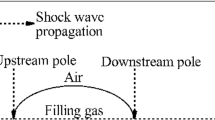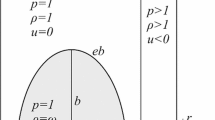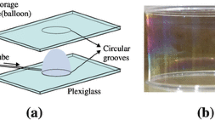Abstract
We present computational results on the evolution of the shock-accelerated heavy bubbles surrounded by nitrogen with the Atwood number A t = 0.497–0.677 and the emphasis is on the jet phenomenon caused by the shock focusing. The multi-fluid Eulerian equation is solved by a finite volume method based on MUSCL-Hancock approach. Based on the numerical schlieren and the distributions of density and pressure, it is found that there are three typical jet structures (outward jet, no jet, inward jet) for different combinations of gas mixture inside the bubble which determine the position of shock focusing relative to the downstream pole of the heavy bubble (upstream of the pole, at the pole, downstream the pole). Compared with the inward jet, the velocity of outward jet is obviously larger. As A t increases, the moment of jet formation is postponed, and the maximal values and magnifications of pressure and density increase distinctly. Therefore, the energy convergence effects are heavily enhanced with the increase of bubble gas density.
Similar content being viewed by others
References
Ma T, Patel P K, Izumi N, et al. Onset of hydrodynamic mix in high-velocity, highly compressed inertial confinement fusion implosions. Phys Rev Lett, 2013, 111: 085004
Yang J, Kubota T, Zukoski E E, et al. Application of shock-induced mixing to supersonic combustion. AIAA J, 1993, 31: 854–862
Jamaluddin A R, Ball G J, Leighton T J. Shock/bubble interaction near a rigid boundary in shock wave lithotripsy. In: Proceedings of the 24th International Symposium on Shock Waves. Jiang Z L, ed. Beijing: Springer, 2005. 1211–1216
Arnett W D, Bahcall J N, Kirshner R P, et al. Supernova 1987A. Annu Rev Astron Astrophys, 1989, 27: 629–700
Rudinger G, Somers L M. Behavior of small regions of different gases carried in accelerated gas flows. J Fluid Mech, 1960, 7: 161–176
Winkler K H, Chalmers J W, Hodson S W, et al. A numerical laboratory. Phys Today, 1987, 40: 28–37
Picone J M, Boris J P. Vorticity generation by shock propagation through bubbles in a gas. J Fluid Mech, 1988, 189: 23–51
Haas J F, Sturtevant B. Interaction of weak shock waves with cylindrical and spherical inhomogeneities. J Fluid Mech, 1987, 181: 41–76
Niederhaus J H J, Greenough J A, Oakley J G, et al. A computational parameter study for the three-dimensional shock-bubble interaction. J Fluid Mech, 2008, 594: 85–124
Ranjan D, Oakley J, Bonazz R. Shock-bubble interactions. Annu Rev Fluid Mech, 2011, 43: 117–140
Zhai Z, Si T, Luo X, et al. On the evolution of spherical gas interfaces accelerated by a planar shock wave. Phys Fluids, 2011, 23: 084104
Si T, Zhai Z, Luo X, et al. Experimental studies of reshocked spherical gas interfaces. Phys Fluids, 2012, 24: 054101
Hawker N A, Ventikos Y. Interaction of a strong shockwave with a gas bubble in a liquid medium: A numerical study. J Fluid Mech, 2012, 701: 59–97
Layes G, Metayer O L. Quantitative numerical and experimental studies of the shock accelerated heterogeneous bubbles motion. Phys Fluids, 2007, 19: 042105
Zhai Z, Si T, Zou L, et al. Jet formation in shock-heavy gas bubble interaction. Acta Mech Sin, 2013, 29: 24–35
Sun M, Takayama K. Conservative smoothing on an adaptive quadrilateral grid. J Comput Phys, 1999, 150: 143–180
Luo X, Prast B, van Dongen M E H, et al. On phase transition in compressible flows: Modelling and validation. J Fluid Mech, 2006, 548: 403–430
Zhai Z, Si T, Luo X, et al. Parametric study on the cylindrical converging shock waves generated based on shock dynamics theory. Phys Fluids, 2012, 24: 026101
Wang M, Zhai Z, Si T, et al. Generation of polygonal gas interfaces by soap film for Richtmyer-Meshkov instability study. Exp Fluids, 2013, 54: 1427
Zhai Z, Wang M, Si T, et al. On the interaction of a planar shock with a light polygonal interface. J Fluid Mech, 2014, 757: 800–816
Fan M, Zhai Z, Si T, et al. Numerical study on the evolution of the shock-accelerated SF6 Interface: Influence of the interface shape. Sci China-Phys Mech Astron, 2012, 55: 284–296
Author information
Authors and Affiliations
Corresponding author
Rights and permissions
About this article
Cite this article
Zou, L., Zhai, Z., Liu, J. et al. Energy convergence effect and jet phenomenon of shock-heavy spherical bubble interaction. Sci. China Phys. Mech. Astron. 58, 124703 (2015). https://doi.org/10.1007/s11433-015-5697-0
Received:
Accepted:
Published:
DOI: https://doi.org/10.1007/s11433-015-5697-0




